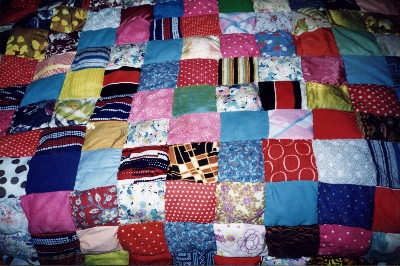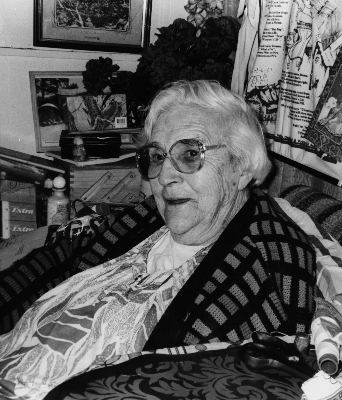Quilt No.632PWH - The Pioneer Women's Hut

1500 x 1200mm
Amy Shore always said the only sewing she did all her life was darning and mending and making Wagga Rugs from jute, wheat or flour bags with cretonne top and backing. In the 1970s her daughter showed her how to make the quilts because 'she wasn't much good for anything else'. Amy made this quilt, one of many, at Murray's Crossing near Tumbarumba NSW in the 1970s. She donated it to The Pioneer Women's Hut. It is displayed occasionally.
1500 x 1200mm
Amy Shore (1901-1999) was married in 1919 and had 8 children. The family always lived on a farm and it was a struggle. "Not long after we came here [Munderoo] things weren't very prosperous and it was coming on Christmas so the boys and I got a drum and made eucalyptus oil to get some money for Christmas. It is quite an interesting job. Anyway we made a gallon and got 9 pound for it.
Some years later I also bred ferrets and at one time, had 70 of them. We used them for rabbiting and would sell the rabbits for meat and also the skins. Mr. Scuppan had a baker's shop in Tumbarumba and we also used to swap small skinned rabbits for bread.I sold the ferrets for 2 pound each and we got our place lined with ferret money. Before that it was hessian���
We also sold beeswax from the native bees to old Mather the skin buyer��..
As my family grew bigger and got older, like all teenagers, were wanting better clothes but money was scarce and not much left after feeding six kids and ourselves. So at one time the kids and I went around to find some dead beasts and get the hair off the manes and tails. We would bring it home and wash it in water and eucalyptus and hang it on the fence. When it dried we would take it in to the old skin buyer. It was a good price as it was wanted to stuff saddles with."
[Amy Shore 'Memories of My Mother' Pioneer Women's Hut publication 1990]

Related Quilts:
2210 x 1850mm
2420 x 1220
1655 x 1215mm
2480 x 1420 mm
1770 x 1740mm
941 x 261mm






